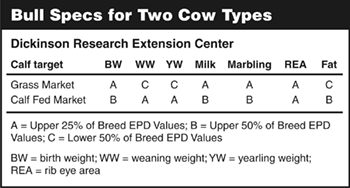
Kris Ringwall
Beef Talk
Simple bull talk
The Dickinson Research Extension Center recently decreased the center's bull population. The average bull age at the center at turnout has been 3 years of age. Seldom would a bull more than 5 years of age be turned out to breed.
As a result, the 10 remaining bulls are two Lowline and eight Red Angus bulls. They will average 3 years of age at turnout next spring. Every time the bull pen is evaluated, one cannot help being concerned about refilling.
 The cash outlay is real. Regardless of weight and price, the cull bull check of $903.50 per head is never as large as the bull buying check needs to be. As a matter of course, the center runs cows in many different pastures and errs on the side of having more bull power, not less, when it comes to stocking bulls.
The cash outlay is real. Regardless of weight and price, the cull bull check of $903.50 per head is never as large as the bull buying check needs to be. As a matter of course, the center runs cows in many different pastures and errs on the side of having more bull power, not less, when it comes to stocking bulls.
At the center, some cows are located in very small pastures, and others in larger pastures, but every pasture needs a bull. The targeted ratio is one bull to 30 cows, but the actual number will vary depending on pasture size. Bull-to-cow ratios are variable throughout the industry. Some producers are adamant that bulls can cover twice the number of cows the center stocks, while others feel more bulls are better.
The center's bull stocking rate has failed only twice in recent times. Several years ago, a set of heifers came off pasture with none of the heifers bred. One bull was utilized, so we only had one bull to blame. We also, in reality, had ourselves to blame. One never can assume bulls are working.
In contrast, we have pasture 50-plus miles away that we graze cows in. This year, we turned four bulls out with the 44 cows on that pasture. However, only 33 cows bred, so more bulls are not always better. In fact, in this case, they were worse.
All of the center's bulls are fertility-checked in the spring, so the four fertile bulls perhaps spent more time deciding their pecking order and less time breeding cows. These were bulls that were 2 years old, but all we can do is speculate if dominance played a factor. All four bulls went to market. We can only speculate that they were still jostling for position as they learned what the word "beef" really means.
Excess bulls are just that, excess. They do not add much to an operation except more bills. For the center, the mature cow herd is targeted at 200. On paper, we would have enough bulls, but as noted earlier, smaller pastures require more bulls.
The other issue, the target calf, is distinctly different because the 200 cows are roughly 120 cows and 80 cows. The 80 cows are targeted to produce heavy-muscled calves with reduced frame and a slightly slower growth rate. These calves will end up on a grass program and are projected for an older yearling market.
The 120-cow herd will produce traditional fast-gaining, high-lean calves for the calf-fed market. These calves will meet the market for calves less than 20 months of age, while the slower-gaining calves will not.
The current bull inventory will sire calves that meet a grass-fed market. The average expected progeny difference (EPD) values for the eight Red Angus bulls are birth weight, -2.3; weaning weight, 26.4; yearling weight, 56.6; milk, 23.5; marbling, 0.28; ribeye area, 0.23; and back fat, 0.02. This means the bull pen is in the upper 25% of the Red Angus breed for birth weight, milk, marbling and ribeye area.
On the growth side, these bulls are in the lower 50 percentile for weaning weight, yearling weight and back fat. Keep in mind these calves are going to grass and will be targeted to market at less than 24 months of age.
 Obviously, the center will need to buy different bulls for the 120 cows designed for the high-growth calf-fed market. Expectations are that these calves will be on the rail at 15-18 months of age. In this case, the growth numbers need to be upped for the second cow herd.
Obviously, the center will need to buy different bulls for the 120 cows designed for the high-growth calf-fed market. Expectations are that these calves will be on the rail at 15-18 months of age. In this case, the growth numbers need to be upped for the second cow herd.
It is always fun to shop for bulls.
Your comments are always welcome at www.BeefTalk.com. For more information, contact the North Dakota Beef Cattle Improvement Association (NDBCIA) Office, 1041 State Ave., Dickinson, ND 58601, or go to www.CHAPS2000.com on the Internet.




